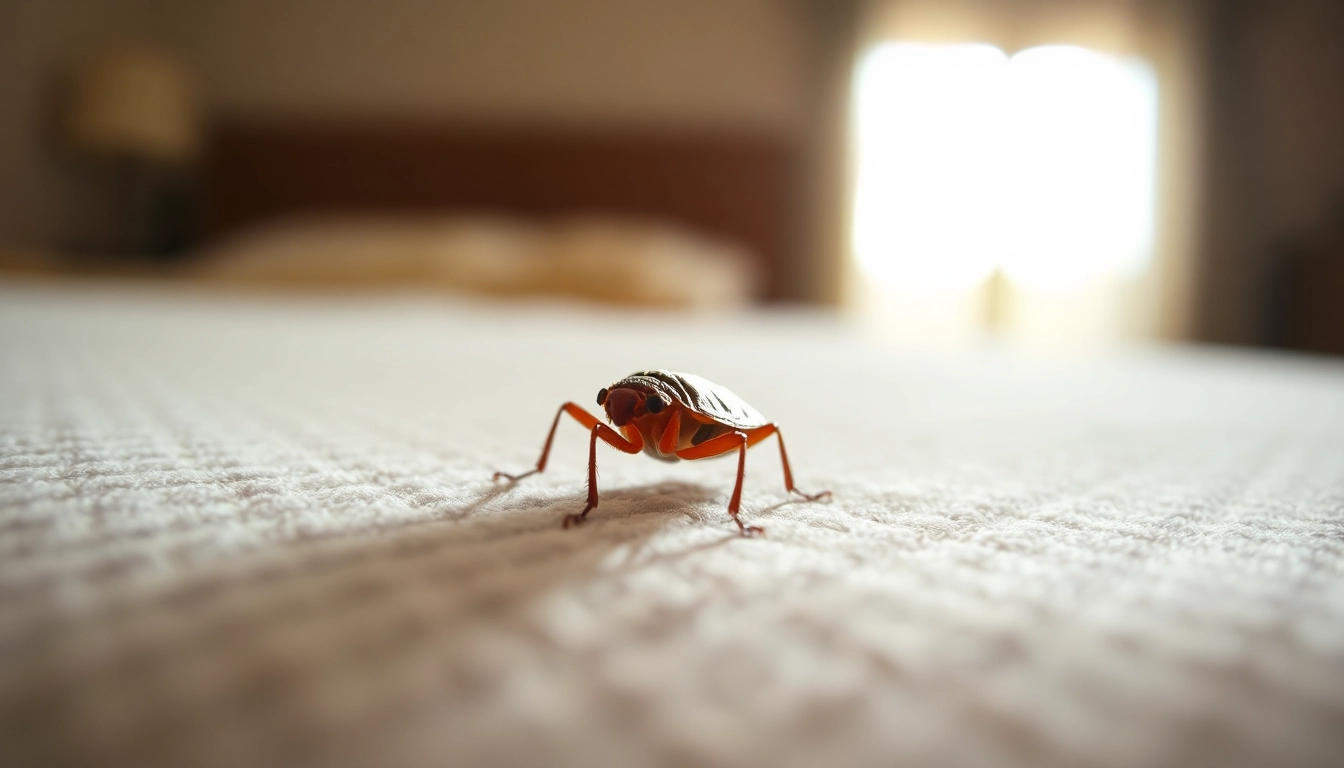Understanding Bed Bugs: The Threat They Pose
Bed bugs have become a significant concern for homeowners and renters alike, particularly in urban settings. These tiny, nocturnal pests are notorious for their ability to hide in crevices, bedding, and other furniture, making them particularly challenging to detect until an infestation has already occurred. As you delve into bed bug pest control, it’s essential to understand their biology, their signs of presence, and the health risks they pose to humans.
Life Cycle and Behavior of Bed Bugs
Bed bugs go through several life stages: egg, nymph (which molts several times), and adult. A single female bed bug can lay anywhere from 200 to 500 eggs in her lifetime, which hatch within 6 to 10 days under optimal conditions. Understanding this life cycle is crucial when considering pest control solutions, as effective methods must target bed bugs at all life stages.
Adult bed bugs are approximately 1/4 inch long, resembling an apple seed or lentil in shape and color. They are most active during the night and are attracted to body heat and carbon dioxide emitted by sleeping humans. During the day, they hide in cracks and crevices, making proper identification and treatment all the more critical.
Signs of Infestation
Identifying a bed bug infestation can be tricky. Common signs include:
- Dark spots: Fecal stains on bedding, walls, and mattress seams.
- Blood stains: Small, rust-colored spots from crushed bed bugs.
- Egg casings: Tiny, yellowish, and transparent shells left behind after nymphs hatch.
- Live bugs: Visible insects, particularly around seams and folds of mattresses and upholstery.
If you notice these signs, prompt action is necessary to prevent the situation from worsening.
Health Risks Associated with Bed Bugs
While bed bugs are not known to transmit diseases, their presence can lead to various health complications. Most notably, their bites can cause red, itchy welts on the skin, leading to secondary infections due to scratching. Furthermore, the psychological stress of living with an infestation can lead to anxiety, insomnia, and other emotional distress.
For some individuals, reactions may be more severe and can include allergic reactions requiring medical attention. Therefore, effective pest control is not only about removal but also about safeguarding your overall well-being.
Effective Bed Bug Pest Control Methods
Effective bed bug pest control encompasses a variety of strategies, each tailored to address different aspects of the bed bug problem. Whether you opt for professional extermination or a DIY approach, understanding the methods available is crucial for success.
Integrated Pest Management (IPM) Approach
The Integrated Pest Management (IPM) approach is widely recognized as an effective strategy for controlling bed bugs. IPM combines multiple tactics, including monitoring, physical removal, and environmentally friendly methods to significantly reduce pest populations while minimizing risk to humans and the environment.
Key components of an IPM strategy include:
- Assessment and Inspection: Conduct thorough inspections to identify the extent of the infestation and the species involved.
- Prevention: Repairing structural flaws and ensuring tight closures to prevent re-entry.
- Monitoring: Utilizing traps to capture and monitor bed bug activity over time.
- Treatment: Implementing a combination of methods, including both chemical and non-chemical treatments.
This proactive approach ensures that treatment is effective and reduces the likelihood of future infestations.
Chemical Treatments: What You Need to Know
Chemical treatments play a significant role in bed bug pest control, especially when dealing with severe infestations. Various insecticides are available, each with specific active ingredients and effectiveness against different life stages of bed bugs. When considering chemical treatments, keep the following in mind:
- Types of Insecticides: These can include pyrethroids, neonicotinoids, and insect growth regulators (IGRs), each with differing effectiveness and residual action.
- Application Methods: Sprays, dusts, and foggers can all be used; however, correct application is crucial for safety and efficacy.
- Safety Considerations: Always follow the manufacturer’s instructions to minimize potential health risks for humans and pets.
In some cases, it may be necessary to hire a licensed pest control professional who can effectively apply these treatments while adhering to safety protocols.
Non-Chemical Methods: Heat and Cold Treatments
For those looking for chemical-free alternatives or supplemental strategies, non-chemical methods such as heat and cold treatments have shown success in eliminating bed bugs.
Heat Treatments: This method involves raising the temperature of an infested area to over 120°F (49°C) for a sustained period, effectively killing all life stages of bed bugs. Professional services may use specialized equipment to ensure uniform temperature distribution.
Cold Treatments: Freezing can also eliminate bed bugs, but it must be done correctly. Items should be exposed to sub-zero temperatures for at least four days to ensure effectiveness.
These methods are particularly useful for treating items that cannot be easily sprayed with chemical insecticides, such as clothing and bedding.
Preparing Your Home for Bed Bug Extermination
Effective bed bug pest control requires preparation. Whether you are preparing for a professional treatment or opting for a DIY approach, following specific steps can enhance the efficacy of your chosen method.
Steps to Prepare a Room for Treatment
When preparing a room for extermination, consider the following:
- Declutter: Remove clutter from the room, which can provide hiding spots for bed bugs.
- Clean and Vacuum: Thorough vacuuming of all areas, including carpets, furniture, and baseboards, can help remove visible bed bugs and eggs.
- Wash Fabrics: All bedding, curtains, and clothing should be washed in hot water and dried on high heat.
- Seal Items: Use plastic bags to seal cleaned and non-infested items to prevent reinfestation.
- Inform the Exterminator: Provide details about the extent of the infestation and any previous treatments you’ve undertaken.
Proper preparation goes a long way in ensuring that treatment is successful and that you reduce the infestation’s chances of returning.
Common Mistakes to Avoid During Preparation
Even with the best intentions, homeowners can make mistakes that hinder effective pest control:
- Ignoring Adjacent Rooms: Bed bugs can easily spread; therefore, addressing only one room can lead to a secondary infestation.
- Using Inadequate Methods: Failing to follow proper cleaning and preparation protocols can lead to ineffective treatments.
- Skipping Follow-Ups: Neglecting to monitor for residual bed bugs post-treatment can allow future infestations to establish.
Avoiding these common pitfalls will empower your pest control efforts, maximizing their effectiveness.
Timeline of Treatment and Follow-Up Care
Upon scheduling a pest control treatment, it’s helpful to understand what to expect regarding timing:
- Day 1: Inspection and preparation day, typically involving the exterminator assessing the extent of the infestation.
- Days 2-4: Treatment days, where various methods are implemented based on the pest control plan.
- Week 1: Follow-up inspection to assess effectiveness and identify remaining bed bugs.
- Ongoing Monitoring: Regular inspection of your living space is key to early identification of future problems.
Understanding the timeline ensures you are aware of your responsibilities and what to look for post-treatment.
Cost Considerations in Bed Bug Treatments
When faced with a bed bug infestation, understanding the costs associated with pest control is crucial in making informed decisions about treatment options.
Factors Influencing Bed Bug Pest Control Costs
The price of bed bug pest control can vary widely based on several factors, including:
- Extent of Infestation: More severe infestations typically require more intensive measures, leading to higher costs.
- Location: Geographic area can also influence pricing due to varying local labor rates.
- Types of Treatments Used: Chemical treatments tend to be less expensive than heat treatments, which require specialized equipment.
For a more accurate estimate, obtaining quotes from multiple pest control professionals is advisable.
DIY vs. Professional Extermination Services
When it comes to bed bug pest control, many homeowners grapple with the decision of whether to handle the problem independently or hire a professional service. DIY treatments may seem cost-effective, but they often have limitations: they can be time-consuming, require purchasing multiple products, and lack the effectiveness of professional-grade solutions.
In contrast, professionals have access to stronger, EPA-approved insecticides and advanced equipment, along with the experience necessary to develop tailored strategies based on the specific situation. While the upfront cost of hiring a professional may be higher, the long-term savings from preventing future infestations can well outweigh the initial investment.
Cost-Saving Tips for Effective Treatments
Here are some strategies to reduce costs while effectively managing bed bug infestations:
- Early Detection: Keeping a close eye on signs of infestation can lead to early intervention, minimizing treatment complexity and cost.
- Bundle Services: Many pest control companies offer discounts for bundling services or treating multiple rooms at once.
- Regular Maintenance: Investing in periodic pest inspections can help maintain an infestation-free home, reducing long-term costs.
By utilizing these cost-saving strategies, you can undertake effective pest control measures without overspending.
Preventing Future Infestations: Best Practices
Once you have dealt with bed bugs, the focus should shift to preventing future infestations. Implementing a robust prevention strategy ensures that your home remains bed bug-free.
Post-Treatment Care
Once treatment is completed, your attention should turn to post-treatment care:
- Continue Monitoring: Regularly inspect your home for signs of bed bugs to catch any potential re-infestation early.
- Seal and Store: Use protective covers on mattresses and box springs to prevent future access.
- Retain Pest Control Documentation: Keep records of treatments and inspections for future reference.
These steps will help maintain the success of your extermination efforts.
Regular Inspections: How to Stay Vigilant
Conducting regular inspections is essential in staying ahead of potential bed bug problems. Here’s how to create a routine:
- Check Sleeping Areas: Weekly checks of mattresses, bed frames, and surrounding areas can help catch infestations before they spread.
- Inspect Furniture: Regularly examine upholstered furniture and decorative items for signs of bed bugs.
- Monitor Travel Habits: After returning from travels, inspect luggage and clothing to minimize bringing bed bugs into your home.
Establishing a vigilance routine aligns with preventative measures and safeguards your living space from future invasions.
Long-Term Strategies for Bed Bug Prevention
Long-term strategies for preventing bed bugs include:
- Education: Familiarize yourself and your family with bed bug signs and behaviors.
- Community Awareness: Engage with your community about shared pest issues, as bed bugs can easily move between neighboring homes.
- Consistent Cleaning Routines: Regular vacuuming and cleaning of fabric surfaces can prevent bed bugs from establishing themselves.
By adopting these long-term strategies, you effectively fortify your home against future infestations.



